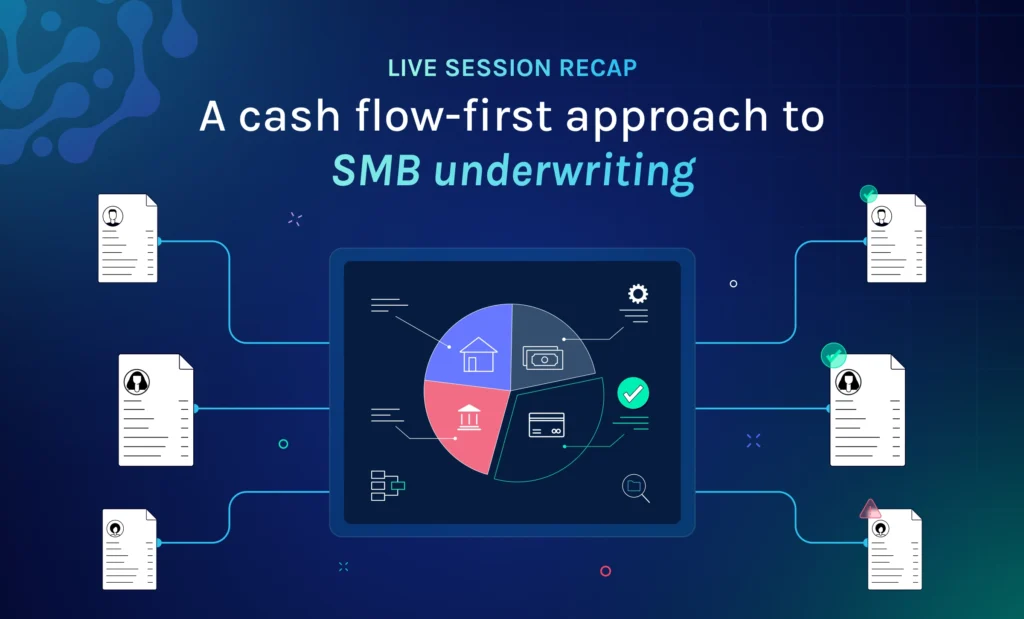Live session recap: A cash flow-first approach to SMB underwriting

For small business funders, a comprehensive view of borrowers’ financial health is necessary to make informed financial decisions.
With a wide range of data sources available, funders need to prioritize the data sets that offer the most accurate assessment of creditworthiness while also helping them avoid unnecessary risk.
Traditionally, funders have relied heavily on credit scores to evaluate a small business’s creditworthiness. However, these methods have limitations, particularly when assessing younger companies or those with limited credit histories.
While credit data is still valuable, it does not always paint a complete picture of a business’ ability to manage debt. Enabled by AI-driven document automation, cash flow data has become more accessible for funders and, in many cases, is rising to the top of their underwriting funnels.
In a recent live session, Expansion Capital Group COO, Herk Christie joined Ocrolus Director of Product Management, Anneika “Nike” Patterson to discuss how ECG has implemented a cash flow-first approach to small business underwriting.
What to consider when building an underwriting funnel
To determine which data sources to use – and in which order they should be – small business funders often look to two key metrics: the ability to decline unqualified applicants incrementally and the cost.
Funders have long used cash flow data for its insights into businesses’ debt capacity, revenue and expenses, recurring transactions and more. However, traditional sources, such as credit bureau data, were often used first due to the complexity of gathering and analyzing bank data. With AI-driven automation, this is no longer the case, as automation enables financial organizations to process cash flow data more efficiently.
The cost of credit pulls has increased in recent years, causing many financial institutions to be more mindful of cost-effectiveness in underwriting. As a result, funders are looking at underwriting through a cost-per-decline lens, especially when dealing with a high volume of leads, to make cost-effective decisions earlier in the process and avoid driving up costs unnecessarily down the road.
A better view of financial health with cash flow-first underwriting
As underwriting costs rise and the accessibility of cash flow data improves, funders are rearranging their underwriting funnels. As a result, lenders can not only identify unqualified applicants more quickly but also approve more businesses that traditional credit checks might have rejected.
ECG has experienced first-hand the benefits of moving cash flow data to the top of its funnel. While the organization saw some predictive value in credit data, it did not consistently paint the complete picture of a business’s health.
ECG found that having low or no credit doesn’t necessarily mean a small business is unhealthy. Many U.S. small businesses have limited or no credit coverage, relying on personal credit to get their business off the ground. With cash flow data earlier in the funnel, ECG can better understand businesses’ true performance based on more accurate signals such as debt capacity, NSFs, overdrafts and revenue and expenses.
While leveraging personal credit is often necessary to succeed, it can damage personal credit scores as entrepreneurs sacrifice their finances to build their businesses. The question for funders becomes how many businesses are being knocked out of the funnel using credit that could have otherwise been carried further through the process.
Benefits of a cash flow-first funnel
By implementing this cash flow-first approach, small business funders gain deeper insights about creditworthiness earlier in the lending process, allowing them to focus on qualified borrowers and write more loans more quickly.
A cash flow-first funnel also helps reduce time and costs spent on credit checks. An applicant may have fantastic credit but an unhealthy business cash flow lurking beneath – or vice-versa. By identifying these unhealthy businesses early through cash flow analysis, funders can avoid running unnecessary credit checks on applicants who would have been disqualified later in the process anyway.
The benefits of bank statement analysis extend beyond cash flow data. Ocrolus signals can point to potential fraud or other red flags within borrower-submitted bank statements, helping identify suspicious activity at the start of the process.
Over time, underwriters who analyze cash flow data within specific industries develop a clear understanding of what healthy businesses look like in each sector. Using cash flow analysis to weed out suspicious-looking businesses, lenders can identify fraudulent applications earlier in the process, detecting suspicious activity that might go unnoticed on credit checks.
Watch the full session here and book a demo to learn how building a cash flow-first funnel helps small business funders make smarter, faster lending decisions.
Key takeaways
- Moving cash flow analysis to the top of the lending funnel helps funders identify unqualified applicants quickly and approve more businesses that traditional credit checks might have rejected.
- While credit data has predictive value, it doesn’t always paint a full picture of business health, especially for small businesses and startups that rely on personal credit to get their business off the ground.
- Bank statement analysis extends beyond cash flow data to help lenders spot potential fraud and other red flags that might go unnoticed in credit checks, particularly when analyzing patterns within specific industries.




